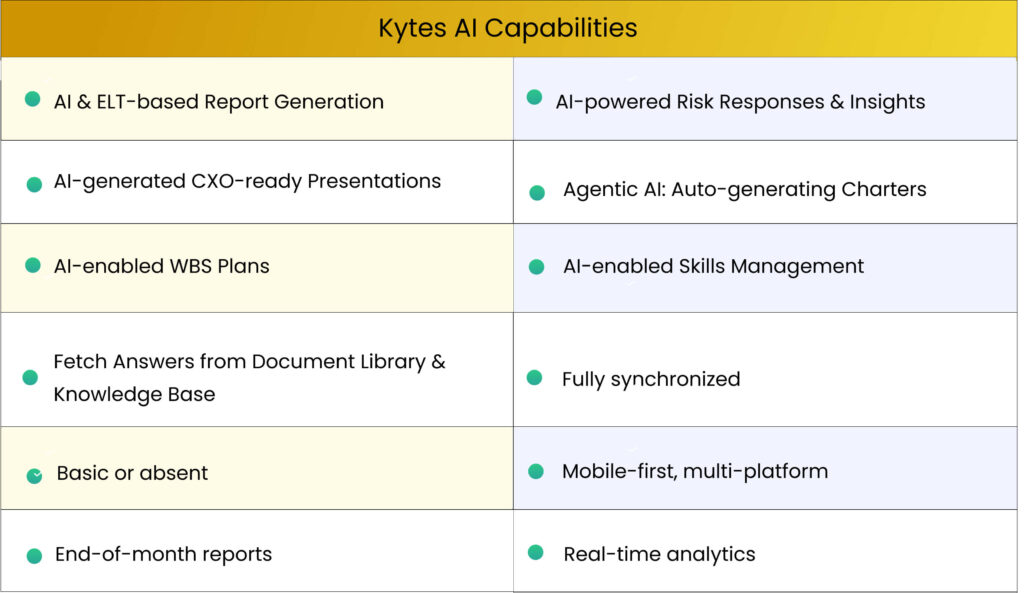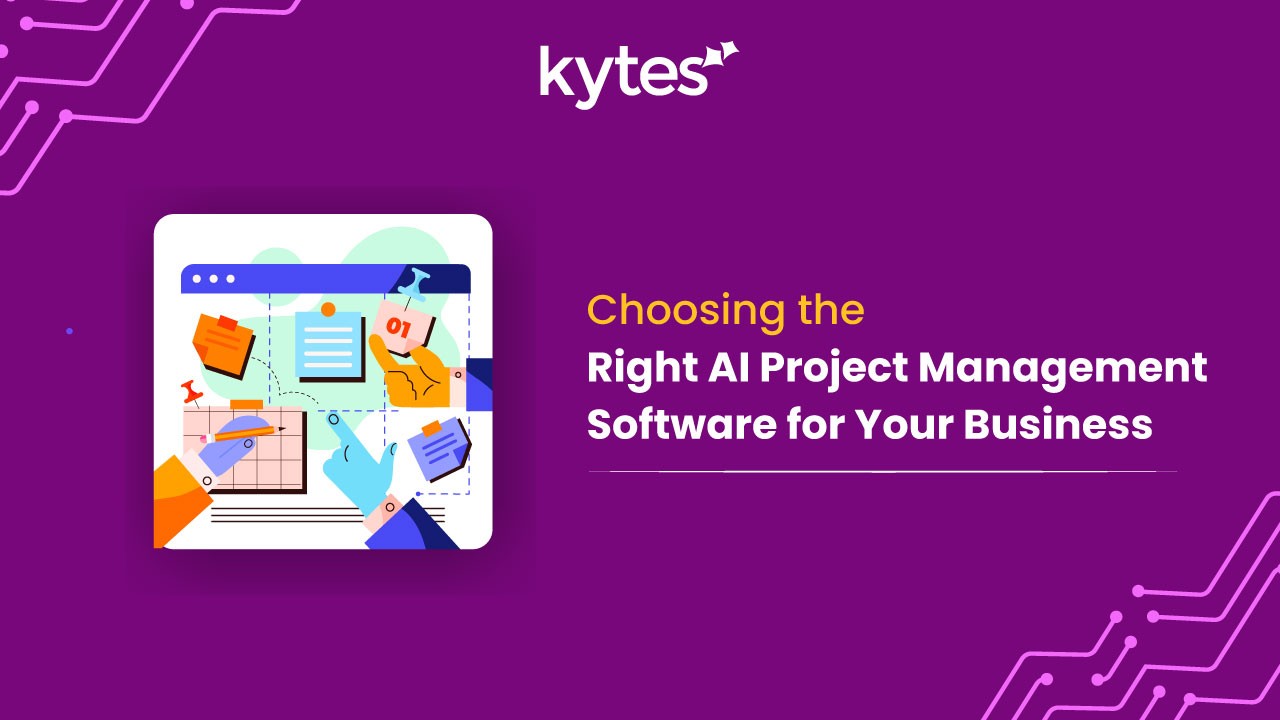Blog Highlights
- Understand what AI project management software is and how it redefines modern enterprise workflows.
- Learn the key differences between traditional PM tools and AI-powered alternatives.
- Discover the must-have features in AI-based project management software, including predictive scheduling and risk forecasting.
- Explore how enterprises can evaluate software options based on scalability, integration, AI maturity, and domain fit.
- Identify common mistakes enterprises make when adopting AI project management tools—and how to avoid them.
- Learn what success looks like post-implementation with clear KPIs and metrics.
- See how Kytes enterprise-grade, AI-enabled PSA+PPM simplifies delivery, compliance, and reporting.
Managing projects today isn’t what it used to be. With hybrid teams, growing client demands, and tighter delivery cycles, businesses face more complexity than ever before. And while traditional project management tools help track work, they often fall short when it comes to agility, foresight, and control.
That’s where AI project management software makes all the difference.
By embedding intelligence into planning, tracking, and execution, project management software with AI helps teams work smarter—not harder. From automating routine tasks to predicting risks and bottlenecks, AI takes project visibility to the next level.
But here’s the truth: not every tool that claims to use AI is enterprise-ready. And not every business is set up to use AI effectively. Choosing the right solution—and having the right systems and data foundation—is critical to getting real results.
In this blog, we’ll break it all down. You’ll learn what makes AI-powered project management software work, what to look for, and how to evaluate platforms that scale with your enterprise. We’ll also highlight how Kytes AI-enabled PSA+PPM brings clarity and control to project-led businesses.
What Is AI Project Management Software?
AI project management software is more than a digital task board or scheduling tool. It’s a platform that uses artificial intelligence to plan, track, and optimize projects—using real-time data and past patterns to guide decisions.
Unlike traditional tools, which rely heavily on manual inputs, AI-powered project management software analyzes project trends and suggests what to do next. It can predict delays, recommend resource changes, or even reallocate tasks based on availability and skills. This gives project managers a proactive edge, especially when handling multiple deadlines and teams.
Another key difference? These tools learn continuously. As your team completes more projects, the AI becomes smarter—fine-tuning its forecasts, recommendations, and alerts. This is particularly useful for enterprise environments where even small decisions can impact delivery timelines or budgets.
Some systems also include natural language processing (NLP), allowing users to update tasks or create schedules using simple commands.
In short, AI in project management shifts tools from passive trackers to intelligent assistants. It’s the evolution of project execution—from static Gantt charts to real-time, insight-driven decision-making.
Why Enterprises Are Adopting AI for Project Management
Enterprises today manage more than just projects. They’re balancing people, portfolios, and profitability—often across global teams and business units. When your systems don’t talk to each other, that complexity becomes chaos.
That’s why more enterprises are turning to AI project management software.
Disparate tools for planning, tracking, resourcing, and reporting lead to silos, delays, and disconnects. What’s needed is a single version of truth—a unified, intelligent workspace that aligns execution with business outcomes.
Here’s where AI-based project management software creates immediate impact:
- Overloaded Teams: AI automates status tracking and nudges team members before deadlines slip.
- Disjointed Data: It consolidates fragmented data to offer real-time, actionable insights.
- Uncertain Forecasts: Predictive models flag cost overruns, delays, and risks before they escalate.
- Global Workforce: Automated timesheet and compliance tools ensure labor law adherence across regions.
- Leadership Reporting: CXOs get real-time dashboards without relying on manual updates.
For enterprise-grade operations, juggling disconnected tools is no longer sustainable. Today’s leading organizations rely on platforms that unify people, projects, and profitability into one cohesive, AI-powered ecosystem—transforming how work gets done at scale.
Must-Have Features in AI-Based Project Management Software
When evaluating AI-powered project management software, enterprises need more than just automation. The right solution should offer intelligence, flexibility, and scalability—all tailored to the complexities of large, project-driven businesses. Here are the essential features to look for:
🔹 Predictive Scheduling and Forecasting
AI learns from historical data, team velocity, and task dependencies to build dynamic project timelines.
For example, if a certain type of task usually takes 20% longer during holidays or due to resource availability, the system automatically adjusts schedules. This reduces overruns and improves delivery accuracy.
🔹 Risk Detection and Alerts
Smart tools flag schedule delays, cost escalations, and resource conflicts before they impact delivery. These alerts are often triggered by deviations from planned vs. actual effort or dependencies between tasks. This is crucial in regulated industries like pharma or engineering, where a small slip can cascade.
🔹 Intelligent Resource Allocation
AI matches people to projects based on availability, skillsets, and past performance. For instance, if two resources are free but one has higher efficiency on similar past projects, AI will recommend the better fit. This improves billability and reduces bench time.
🔹 Natural Language Processing (NLP)
Team members can create or update tasks using everyday language. Say “Assign design review to John next Tuesday” and the system automatically schedules it. This reduces friction and saves time, especially for non-technical users.
🔹 Real-Time Dashboards and CXO Reports
No more Excel wrangling. Executives can view revenue forecasts, resource utilization, and risk heatmaps—automatically updated and role-specific. Tools like Kytes even generate PowerPoint decks for monthly reviews.
🔹 Timesheet and Compliance Automation
From geo-fencing for location-based tracking to labor law alignment across regions, enterprise tools handle compliance automatically—cutting down audit risks.
🔹 System Integrations
Look for platforms that connect with ERP, CRM, HRMS, and finance tools like SAP, Salesforce, or Workday. Integration ensures data consistency and removes the need for manual reconciliation. Kytes AI-enabled PSA+PPM combines all of the above and even more into a seamless experience, purpose-built for complex, compliance-driven industries.
Kytes AI in Action
Most teams still juggle spreadsheets, chase updates, and manage in silos. Kytes changes that.
Watch how Kytes AI-enabled PSA+PPM software digitizes, automates, and optimizes project lifecycles—with intelligence embedded across 20+ modules.

How to Evaluate the Right AI Project Management Software for Your Enterprise
Choosing the right AI project management software isn’t just about ticking boxes on a feature list. For enterprises, it’s a strategic decision that can directly impact delivery timelines, resource efficiency, compliance, and profitability.
Here’s how to evaluate a solution that truly fits your enterprise environment:
🔹 Enterprise Scalability
Can the platform support complex portfolios, multi-level governance, and thousands of concurrent users? It should work equally well across departments, geographies, and verticals.
🔹 Intelligence Depth
Does it go beyond simple automation? Look for systems that offer predictive analytics, real-time risk alerts, and context-aware recommendations—not just task bots.
🔹 Domain-Specific Flexibility
The software should adapt to your industry’s unique workflows. Whether you’re in pharma, consulting, or engineering, you need workflows that fit your business—not the other way around.
🔹 Seamless Integration
Ensure the tool integrates effortlessly with your ERP, CRM, HRMS, accounting, and document management systems. This avoids duplicate data entry and gives everyone access to a single source of truth.
🔹 Security and Compliance
Enterprise systems must adhere to global standards, including SOC 2, ISO 27001, and GDPR. Ask for detailed documentation and audit readiness.
🔹 User Experience and Adoption
A powerful platform isn’t helpful if your teams don’t use it. Prioritize intuitive UI, role-based views, and in-app guidance that makes adoption frictionless.
Kytes checks all these boxes and more. With deep configurability, AI at the core, and built-in compliance, it’s purpose-built for enterprise-grade delivery, reporting, and optimization.
Questions to Ask Before You Commit
Before selecting any AI-based project management software, go beyond the surface. Ask questions that reveal how well the platform fits your enterprise’s complexity, scale, and industry nuances.
Here are the essentials:
- What types of AI models are embedded—predictive, generative, agentic?
- Can the AI deliver contextual recommendations from real-time project data?
- How does the system learn and adapt based on our usage patterns?
- Does it support real-time integration with ERP, CRM, HRMS, and finance tools?
- How customizable are dashboards, workflows, and reports across departments and roles?
- Does the platform support on-premise as well as cloud deployment?
- What kind of post-implementation training, support, and success tracking is provided?
- What’s the typical time to value (TTV) for enterprises like ours?
- Does the vendor have proven expertise in our industry or domain?
These questions help uncover more than capabilities—they reveal readiness.
The right AI project management tool should align with how your business runs, scale as you grow, and deliver outcomes that matter.
Mistakes Enterprises Should Avoid
Even the most promising AI project management software can fall short if chosen or implemented without care. Here are common mistakes enterprises should avoid—along with real-world examples.
🔹 Mistake 1: Prioritizing UI over capabilities
A visually appealing dashboard may look impressive during a demo, but if it lacks predictive capabilities or customization, your teams will outgrow it fast. One IT services firm had to switch platforms within a year due to limited forecasting features.
🔹 Mistake 2: Ignoring integration readiness
A leading pharma company faced months of delays because their new PM tool didn’t sync with their existing ERP and HRMS. The cost? Duplicate data entry, misaligned reports, and frustrated teams.
🔹 Mistake 3: Overlooking industry fit
Generic tools may not support compliance workflows or domain-specific templates. An engineering consultancy struggled with contract lifecycle management—because the tool lacked milestone-based billing workflows.
🔹 Mistake 4: Underestimating change management
Buying software is easy. Driving adoption is harder. Without proper training and role-based access, teams may stick to old habits, reducing your ROI.
The takeaway? Choose a platform that fits your data landscape, supports your people, and speaks your industry’s language.
Why a ‘Systems First’ Approach Matters
Imagine a powerful engine without a chassis. No matter how advanced it is, it can’t move on its own. That’s exactly what happens when enterprises try to apply AI to broken or fragmented systems.
AI doesn’t magically solve inefficiency. It amplifies whatever systems it runs on.
If your project data lives in silos—scattered across spreadsheets, disconnected tools, and outdated workflows—then even the best AI project management software won’t deliver value. Before AI can think, prioritize, or optimize, it needs structure.
That’s why leading enterprises take a “systems first, AI later” approach.
They begin by implementing integrated platforms that unify project planning, financials, resourcing, and compliance. Once that foundation is solid, AI can layer on top—making recommendations, predicting outcomes, and driving real-time decisions with confidence.
Think of it as building the runway before the plane takes off.
With Kytes AI-enabled PSA+PPM, the system and intelligence are designed to work hand in hand. You get a single version of truth—and AI that adds value from day one.
Final Thoughts
AI in project management isn’t just a tech trend—it’s the next standard for enterprise success. But choosing the right solution takes more than checking boxes. You need a platform that understands your industry, scales with your business, and translates data into decisions.
Whether you’re in IT services, pharma, or engineering, aligning execution with strategy requires more than good intentions—it needs the right tools.Kytes AI-enabled PSA+PPM is one such platform—built for enterprises that prioritize compliance, foresight, and results. If you’re serious about transforming project delivery, it’s time to explore how AI can work with you, not just for you.





